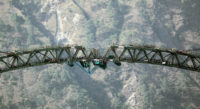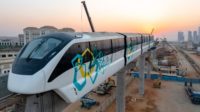Deck work is beginning on the world’s longest high-speed railroad arch bridge, a 384-meter-long span over Spain’s Almonte River that will carry high-speed rail between Plasencia and Badajoz.
With the concrete arch, some 70 m high, completed last summer, the stays are being removed from the centerpiece of a 966-m-long viaduct on the 165-kilometer new stretch of the 450-km Madrid-Extremadura high-speed route.
When the arch was closed last August, it became the world’s longest in either steel or concrete built for a high-speed railroad, according to the national railroad infrastructure administration, ADIF.
The arch surpassed China’s Dashengguan bridge spanning 336 m over the Yangtze River on the Beijing-Shanghai line. The span is also the world’s third-longest in concrete for any use, following China’s Wanxian Bridge (420 m) and Croatia’s Krk crossing (390 m).
To cross the river without temporary supports, ADIF’s designer with the joint venture of Arenas y Asociados, Madrid, and Bilbao-based IDOM Ingeneria y Consultoria reviewed various options, including cable- stayed and truss structures.
Because of the arch’s size and planned erection method, wind specialists with sub-consultant Oritia & Boreas S.L., Granada, commissioned model tests by the Alan G. Davenport Wind Engineering Groupat the University of Western Ontario, Canada, in 2010.
From its 19-m-wide abutments, the arch rises on two legs which converge to form a single box section along the central 210 m. The octagonal section has varying dimensions with depths of about 4.2 m to 4.8 m, and widths of 6-6.5 m. The arch will support the concrete box girder railroad deck at 42-m intervals.
ADIF signed a contract for the viaduct’s detailed design and construction to the AVE Alcántara-Garrovillas joint venture in September 2010. Madrid-based FCC Construcción S.A. controls 85% of the joint venture with Portugal’s Conduril Engenharia, S.A., Ermesinde, holding the balance.
The contract also covers 6.3 km of the line around the viaduct, including several major structures. The current value for all this work is $120 million, some 10% above the original because of change orders at various locations, according to an ADIF official.
FCC/Conduril broke ground in March 2011 and is now on course to hand over the ADIF this June or July, says project director Pedro Cavero de Pablo. The original deadline was 2013, but the schedule was adjusted according to the pace of the overall construction along the entire line, according to an ADIF spokesperson.
The joint venture built the arch with cast-in-place concrete, supporting it with cables tied back to the abutment piers on either side of the river. As the arch grew, the cable stays got higher and the contractor erected tall temporary towers on the piers to anchor them. Meanwhile, crews used temporary tower cranes to work over the river.
After the final concrete pour last August, the contractor has removed all the temporary works except for some stay cables below deck level. Arch-top piers are now in place, and the moveable scaffolding needed to complete the deck is close to completion. Only when the deck is done will the final stays go, says Cavero.
Spanish Ambitions
Elsewhere along the contract’s 6.3 km, FCC/Conduril is now making “some finishing touches” ahead of the planned summer handover, says Cavero.
This package of work is one of 16 being procured by ADIF on the 128-km Talayuela-Cáceres section of the line, which originally was meant to reach the Portuguese capital, Lisbon.
But with Portugal’s section on hold since the government’s debt crisis began, the border is as far as the line goes for now. Even so, “the new rail connection between Madrid and the Spanish region of Extremadura makes sense for itself,” notes ADIF’s spokesman.
With several new projects planned across the country, the truncated Madrid-Lisbon line seems not to have diminished Spain’s enthusiasm for high-speed railroads.
The 1992 World Fare in Seville prompted Spain’s first high-speed route from that southern city to Madrid. By 2005, 550 km of lines were in operation, according to ADIF. Then the pace of construction accelerated, with around 2,750 km of lines completed in the last decade and another $4 billion budgeted for this year.











.jpg?height=200&t=1654624305&width=200)
Post a comment to this article
Report Abusive Comment